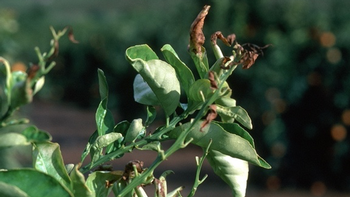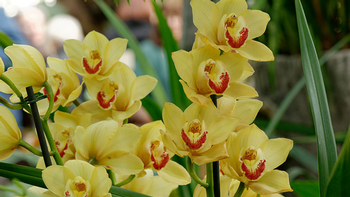Spring 2024
Gardener's checklist for spring
MARCH

Maintenance and prevention
- Chop up cover crop foliage into small pieces if you grew a cover crop. Turn under or add the clippings to your compost pile.
- Replace path mulches that have been washed away by heavy rains.
- Apply two to four inches of mulch where existing mulch is thin or soil is bare, especially around newly planted trees and shrubs. Keep mulch back a minimum of 3 inches from tree trunks and 6 inches from perennials to discourage pathogens.
- Inspect irrigation system for leaks and non-functioning emitters and sprayers. Make any needed repairs or changes.
- Protect sensitive plants from cold injury when frost is predicted. Late frost is possible.
- Sharpen pruning shears and other garden tools as needed. Clean and disinfect your pruning shears after use. Finish with a light coat of oil to protect the blades.
- Eliminate standing water in gutters, drain pipes, and flowerpots to deter mosquitoes.
- Clean winter debris from ponds, fountains, and bird baths.
- Deadhead spring blooming bulbs. Leave the foliage in place to wither naturally and reenergize the bulb for next year.
Planting and propagating
- Shop for rhododendrons, camellias, and azaleas while they are in bloom.
Cutting and pruning
- Prune freeze damaged plants after all chance of frost has passed.
- Prune fuchsias after chance of frost passes.
- Finish pruning roses and planting new roses.
- Clean up dropped leaves and old mulch around pruned roses.
Pests and weeds
- Handpick snails and slugs after dark or apply pet-friendly bait.
- Be diligent about pulling weeds before they set seed.
- Apply one to four inches of mulch around plants and on bare areas of the garden to suppress weeds and help retain soil moisture as winter rains subside. Keep mulch away from the crown of plants.
- Water in early morning if irrigation is required, to prevent foliage staying wet overnight. This can attract snails and slugs and cause fungal diseases.
Feed and fertilize
- Test soil for pH, nitrogen (N), phosphorus (P), and potassium (K), and apply appropriate organic fertilizer.
- Apply compost or organic all-purpose fertilizer to trees, shrubs, and perennials, especially those that were planted last fall.
- Repot houseplants and give them their first feeding. Spring is the best time.
- Feed citrus trees with organic fertilizer if needed.
- Fertilize azaleas, camellias, and rhododendrons with an organic fertilizer after they have bloomed.
Edibles
- Prepare beds for planting.
- Hang codling moth traps in apple, pear, and plum trees.
- Plant starts of arugula, asparagus, broccoli, cabbage, cauliflower, celery, chard, collard greens, kale, leeks lettuce, bunching onions, peas, and rhubarb.
- Learn more about crops to plant in March and other activities in the edible garden.
APRIL

Maintenance and prevention
- Troubleshoot irrigation system for missing or clogged emitters and broken spray heads.
- Begin irrigation as rainy season ends.
- Mulch around new plants to suppress weeds and retain moisture.
- Renew mulch around existing plantings. Keep mulch clear of stems and trunks.
- Clean winter debris from ponds, fountains, and bird baths.
Planting and propagating
- Plant summer bulbs, corms, and tubers, such as callas, cannas, dahlias, gladiolus, and tuberous begonias.
- Take softwood cuttings of trees and shrubs that have flowered.
- Sow seeds of summer to fall blooming annuals. Keep planting beds moist.
- Plant a tree or shrub for Earth Day or National Arbor Day.
Cutting and pruning
- Prune back herbaceous perennials such as salvia to promote plant bushiness.
Pests and weeds
- Check often for aphids on tender new plant growth. Remove infestations with a hard spray of water or insecticidal soap.
- Handpick snails and slugs after dark or apply pet-friendly bait.
- Be diligent about pulling weeds before they set seed.
- Avoid using pesticides that may harm beneficials that feast on aphids, mites, whiteflies, and other insects.
- Keep an eye out for early signs of insect infestation—blast any you see with a garden hose.
- Set yellowjacket traps at the perimeter of the yard (not near eating areas) to discourage yellowjackets from visiting.
Feed and fertilize
- Feed lawn with a slow-release organic fertilizer.
- Renew container plants by adding a slow-release organic fertilizer or repotting in fresh soil.
- Fertilize spring bulbs after bloom using an organic fertilizer. Remove dead flowers but not the leaves until they wither.
- Fertilize citrus if needed, using an organic fertilizer.
- Apply chelated iron to azaleas, camellias, and gardenias if leaves are yellowing between the veins.
Edibles
- Move frost-tender seedlings and plants outdoors if weather permits. Harden off transplants before planting by gradually exposing them to outdoor conditions.
- Thin fruit on apple trees.
- Plant arugula, broccoli, celery, cucumber eggplant, ground cherries, kale, leeks, lettuce, bunching onions, peppers, pumpkins, squash, and tomatoes. Use crop extenders (covers) for heat loving crops.
In cooler areas, plant cabbage, cauliflower, chard, collard greens, spinach, peas. - Learn more about crops to plant in April and other activities in the edible garden.
MAY

Maintenance and prevention
- Check hose fittings for spent washers and leaks. Ensure hose has a shut off valve or other water conserving feature.
- Aerate and fertilize lawn areas using an organic fertilizer. Re-seed bald patches and start mowing warm-season turf.
- Replace any undesirable plants in containers and replenish soil, mixing in compost. Inspect for root rot (favored by excessive water and poor drainage).
Planting and propagating
- Repot cymbidium orchids if they have outgrown their containers or if the planting medium has broken down.
- Continue to plant seeds of summer and fall blooming annuals.
Cutting and pruning
- Prune spring-flowering shrubs after bloom is past.
- Pinch back chrysanthemums and annual flowering plants to encourage branching and compact growth.
- Cut off spent flowers for continued bloom.
- Prune azaleas, camellias, and rhododendrons after they have finished blooming. Feed with a balanced organic fertilizer formulated for acid-loving plants monthly during the spring and summer.
- Prune pines.
- Remove canes that are growing inward on modern roses. This aids in air circulation. For old garden roses that bloom only once, do the major prune after the bloom cycle is complete. Pick up diseased leaves.
Pests and weeds
- Monitor and control snails, slugs, and aphids.
- Use beneficial nematodes to manage grubs in your lawn.
- Keep an eye out for early signs of insect infestation—blast any you see with a garden hose.
- Set yellowjacket traps at the perimeter of the yard (not near eating areas) to discourage yellowjackets from visiting.
Feed and fertilize
- Fertilize citrus if needed, using an organic fertilizer.
Edibles
- Move frost-tender seedlings and plants outdoors if weather permits.
- Harden off transplants before planting by gradually exposing them to outdoor conditions.
- Thin fruit.
- Remove remaining spring crops and prepare beds for summer crop.
- Plant beans, bunching onions, cucumbers, eggplant, ground cherries, kale, lettuce, melons, peppers, squash, and tomatoes.
- In cooler areas, plant arugula ,beets, broccoli, cabbage carrots, celery, and peas.
- Learn more about crops to plant in May and other activities in the edible garden.
